
How These Cognitive Biases Lead You To Poor Choices
There are many cognitive biases that lead you to poor choices and decisions, pushed on to you from many different sources, such as social media and ill-informed friends.
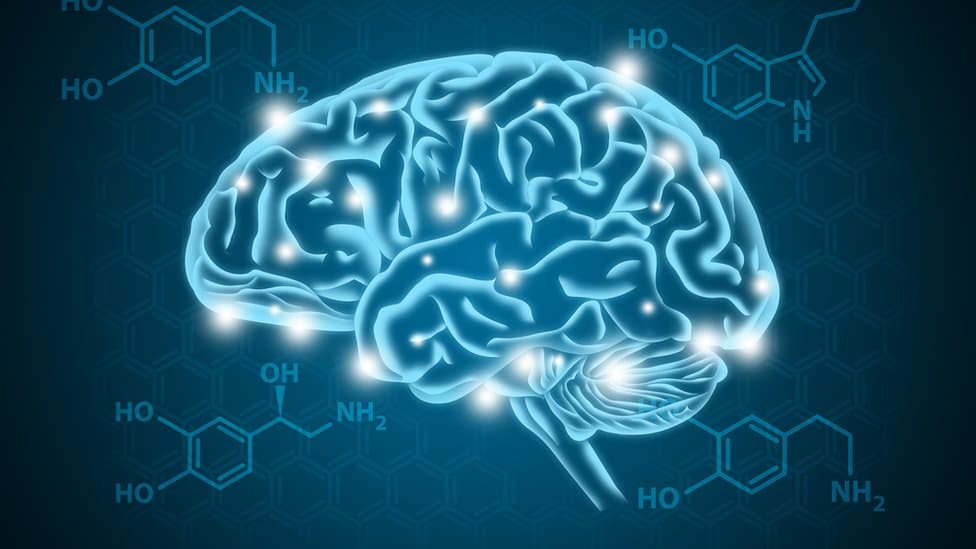
From curbing your appetite by stapling a pressure point inside your ear to the “air diet” which has you “tricking” your mind into eating actual air, there is no shortage of dubious detoxes that likely cause more harm than good.
The dopamine detox is one of the latest trends, but does this concept deserve more credibility than its fallen peers? The answer is yes, but with a pinch, or perhaps a handful, of salt.
This article will guide you through everything you need to know about a dopamine detox. Note that detox is a loose and unscientific term; what we really mean is regulating our dopamine release back to healthy levels for those where too much has become counterproductive.
And in this day and age, with seemingly constant stimulation from social media, gaming, and the internet, we could all benefit from pulling back a little.
A dopamine detox, in this context, is perhaps a tad dramatic. What we really mean is reducing those activities and experiences that spike our dopamine levels too intensely and frequently.
Like anything, healthy consumption lies in moderation, so we are trying to reduce the frequency and intensity of dopamine release for those who suffer from the adverse effects of overindulging.
Dr. Cameron Sepah is widely acknowledged as the creator of the “dopamine fast”, a loose term for limiting impulsive behaviors that create an unhealthy dependence on dopamine-inducing activities.
He aims to tackle some of the most common consequences of unhealthy behavior caused by the overuse of dopamine, including:
By “detoxing” (limiting) our urges to indulge in these behaviors, we can begin to break our dopaminergic reliance on them, reducing unhealthy consequences such as addiction and depression, while maximizing the benefits from healthy levels, including greater motivation and focus in all areas.
A dopamine detox is often confused with a dopamine fast; you cannot fast dopamine like you can food or alcohol, because you have no conscious control over its production.
Dopamine release is an autonomic behavior, and although we can limit some activities that release it, we cannot abstain from it altogether.
Nor should we want to. With too little dopamine we fall below our baseline level required for healthy regulation of the body’s basic functional needs, such as motivating us to go to work and controlling our movement functions.
What people mean when referring to dopamine fasting, therefore, is limiting those activities that draw upon unnatural levels and return them back to normal.
It may seem like a technicality, but it is crucial to clarify that we should never seek to limit our dopamine below our background baseline level. A detox is for those who have consistently overexposed themselves to dopamine spikes to a point where it has become counterproductive.
Before we can successfully and healthily detox from dopamine, we first need to understand what exactly it is.
Dopamine is a neuromodulator – a chemical compound that influences the modulation of many other neurons. You can think of it as a messenger molecule in the brain that allows specific nerve cells to communicate with one another.
This neural communication occurs via two main neural pathways: the nigrostriatal pathway, responsible for movement, and the mesocorticolimbic pathway, which regulates motivation and reinforcement learning.
Of most interest to us, however, is the reward-seeking behavior dopamine produces, noticeable in all mammals and even some plants.
While most classify dopamine as the “pleasure” hormone, psychologists and neuroscientists are particularly interested in how it provides the motivation, drive, and craving to achieve goals and overcome challenging tasks.
Although dopamine plays a role in many functions, including hormone control and regulating insulin production, researchers often focus on one trait in particular – motivational salience.
Dopamine provides you with the effort needed to overcome mental resistance.
When you don’t want to go to the gym, for example, the release of dopamine (through the anticipation of pleasure or reward) will create the energy needed to overcome this resistance. As a result, we feel motivated and driven to achieve a goal despite any short-term pain.
This reward-seeking behavior has roots in our Homo sapien hunter-gatherer days when obtaining resources, such as food, wasn’t as simple as it is today, such as a quick trip to the supermarket.
Thousands of years ago, foraging for resources such as food, shelter, and social interaction came with considerable danger. Whether it be territorial disputes, navigating predators, cuts leading to infection, or leaving your dependents alone and vulnerable, we needed the motivation to overcome these risks despite our inherent cravings for safety.
Dopamine is the universal currency for foraging and seeking. It trades the risk of immediate short-term danger for the greater good of longer-term prosperity. It motivates you to expose yourself to danger now so you will have the safety of food and shelter later.
Motivation, pleasure, and reward sound great, right? Why would we want to limit these positives, and how can too much be harmful?
Like most good things, too much can quickly turn negative. Dopamine is no different. Overindulging will have counterintuitive effects, including lowering motivation and pleasure from activities you once used to enjoy.
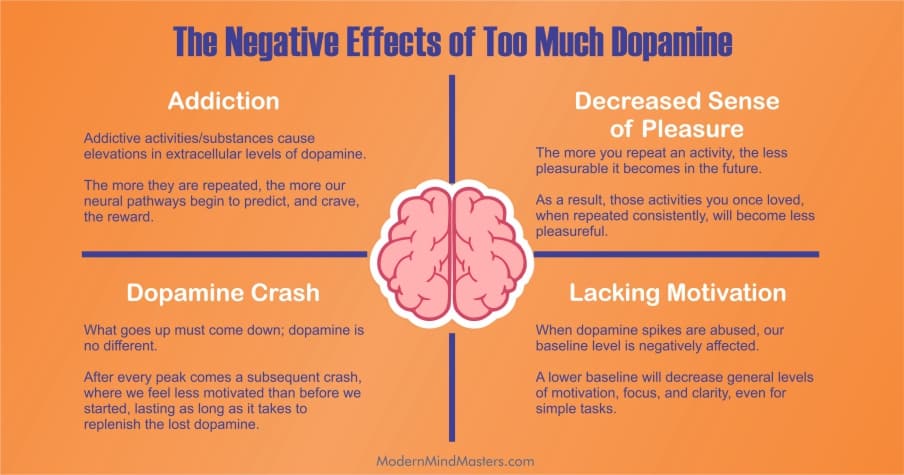
Dopamine releases into our systems through two separate mechanisms; tonic and phasic firing.
We most readily identify phasic firing, where dopamine spikes in response to external stimuli, such as eating delicious food or watching a fascinating movie. Here, addictive substances and activities/habits cause elevations in extracellular levels of dopamine.
While this is great for motivating us to complete a task or seek pleasurable/rewarding experiences, the more we consistently repeat these activities, the more our neural pathways learn to respond to stimuli that immediately precede and reliably predict the reward.
As these predictors are learned, our phasic firings begin to fire to increasingly early predictors.
In other words, when repeated constantly, our brain learns the patterns of when it can expect dopamine and begins to prime the body for it earlier and earlier. When taking addictive drugs, for example, we start to crave them more and more, to the point where it becomes difficult to actively delay or stop.
The more you repeat an activity, the less pleasurable it becomes in the future. Smokers, for example, need to smoke stronger cigarettes to feel the same relief. Similarly, alcoholics need to move on to harder liquors.
Without a break between repeated activities, (without resetting your dopamine history), each repetition affects how much enjoyment you will induce from the next one, meaning a decrease in pleasure from the same activity each time you repeat it.
What goes up must come down. Dopamine is no different.
We have a reserve pool of dopamine in our systems at all times, and when the brain initiates phasic firing from external simulations, we consume dopamine from this pool.
Dopamine is slow to synthesize, however, meaning that for really exciting stimuli, where we release lots of dopamine, it is consumed faster than it can be replenished.
This leads to an inevitable “crash”, where our dopaminergic levels transiently drop beneath our baseline level required to feel motivated and satisfied. As a result, we temporarily feel less motivated than before we started, lasting as long as it takes to replenish enough dopamine to end the deficit.
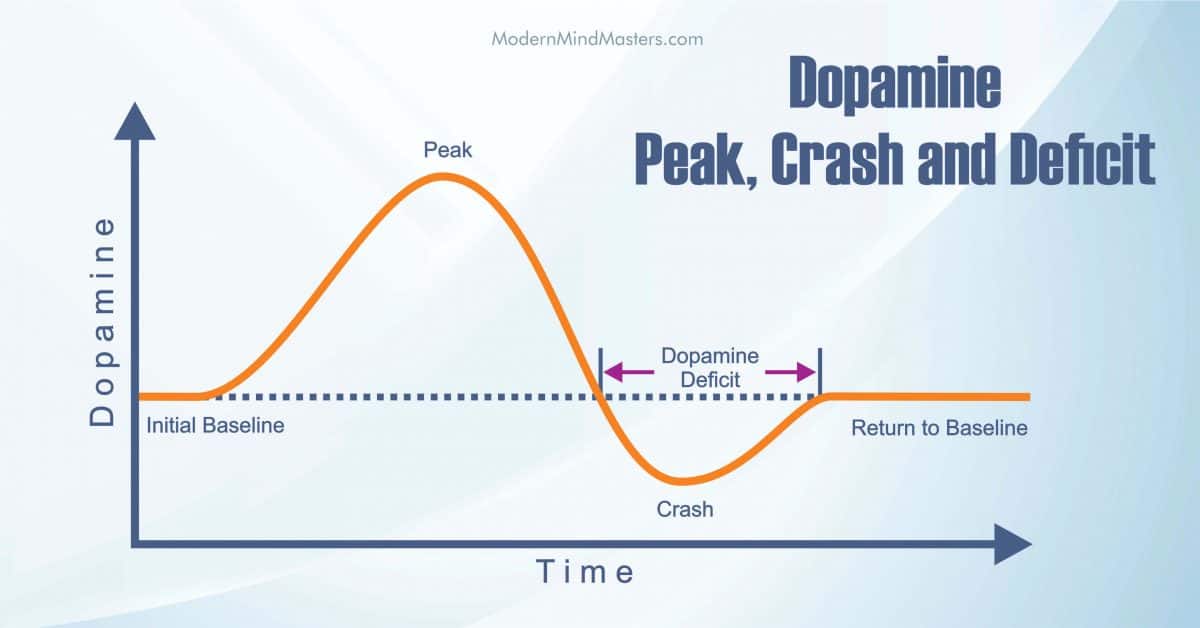
In other words, the more dopamine we consume, the worse we are likely to feel afterward. While this is a natural phenomenon, excessive use of dopamine spikes will worsen these crashes to unhealthy levels.
Your baseline levels determine your general sense of motivation without external stimuli. Neuroscientists call this type of dopamine production tonic firing.
When we crash and dip below our baseline, we will lack the motivation to perform even basic tasks until enough time has passed to replenish our baseline level.
But by constantly spiking dopamine before it can fully replenish, we extend the time spent in this deficit. As a result, our general level of motivation, focus, and satisfaction with life is compromised.
Even small and seemingly easy tasks become difficult; for someone with healthy levels, cleaning the house will be no problem at all. For those with lower baseline levels, however, even cleaning their room will seem like a huge barrier to overcome.
By “detoxing”, that is, reducing our unhealthy reliance on overly intense or frequent spikes, we can benefit in multiple ways.
Once your dopamine has reset to normal levels, you will feel greater pleasure and motivation from external stimuli, whether gaming, fishing, exercising, or sex.
Yes, if you had been overindulging in such activities, after a detox, they will all become more pleasurable even when performed less.
With natural levels in your system, you can spike higher above your baseline, resulting in heightened sensations of pleasure (see this article for how pleasure is related to the difference between baseline and peak dopamine). As a result, you will feel greater enjoyment from these activities.
By leaving enough time between your peaks, you can keep your body guessing when the next dopamine spike will be, avoiding the dangers of addiction and the tendency for regularly repeated activities to become less exciting.
This concept is called your dopamine history and is the notion that your past dopamine peaks interfere with and influence your present and future ability to experience motivation and pleasure.
Remember, dopamine causes addiction when the brain learns when and where it can be expected and encourages you to chase it. When you keep these peaks intermittent and random, it cannot make this association, and cannot create the addictive link.
With elevated levels of baseline dopamine, you will feel an all-around improvement in motivation and general clarity, even when not exposed to external stimuli. As a result, you will not need to chase any substances of activities to feel satisfied and motivated – it will naturally be present.
There is no magic cure here; if there were, few would suffer from depression or addiction. But there are some simple, albeit somewhat challenging, activities you can perform to help reset your dopamine back to healthy levels.
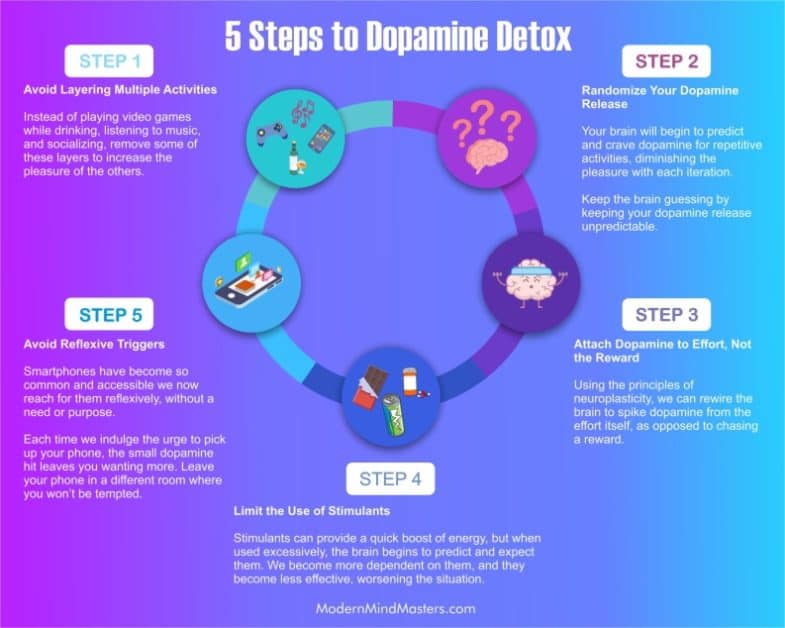
The only thing worse than one bad activity is combining many.
If you play video games while listening to music, drinking alcohol, and talking with your friends, you have layered four separate dopamine-inducing activities together at once.
Done regularly, you will exhaust your reserves of dopamine faster than they can be replaced, and subsequent peaks will release less (resulting in less pleasure) while crashing just as hard (meaning feeling unmotivated once finished).
To make matters worse, by performing these activities regularly, the body will learn to anticipate and crave them, increasing the likelihood of addiction while diminishing the pleasure returned with every repetition.
To combat this, remove layers from some activities. Play video games on their own, without any other external stimulations such as alcohol and music. Go to the gym without a pre-workout or listening to music.
If this proves too challenging (you are essentially kicking a small addiction), remove a stimulus one at a time, and continue to remove them as you become increasingly accustomed to it.
After a few weeks, once your dopamine has reset, you will receive much more pleasure from these activities.
To avoid the diminishing effects of regularly repeating dopamine-inducing activities, we should seek to limit how often we indulge in them. There is no hard and fast rule here (it depends on your individual baseline level), but there are some fundamentals that will avoid overuse.
Keep your dopamine releases random. Try not to let the body become accustomed to a particular activity or substance, and avoid letting it predict when dopamine can be expected. Take that pre-workout on Monday one week, and Wednesday and Friday the next. Ideally, you should limit its use to when genuinely needed.
By keeping your body guessing, the effects will always be fresh without interference from your dopamine history.
The same applies to all other activities. From gaming to sex, keeping dopamine peaks intermittent, and keeping your brain from predicting and expecting spikes, will allow you to use each activity for its maximum benefit.
One interesting idea from neuroscientist Andrew Huberman is that by actively engaging the prefrontal areas of the brain (that is, using our conscious mind), we can learn to rewire our neural paths (through neuroplasticity) to attach dopamine to the effort of a task itself, as opposed to a material reward.
“Don’t spike dopamine prior to engaging in effort, and don’t spike dopamine after engaging in effort. Learn to spike dopamine from effort itself.”
Andrew Huberman Tweet
This is the mechanism behind intermittent fasting for weight loss, which has proved time and again to be the most consistent way to lose weight. Check out the video below to see how we can start doing this.
Many substances elevate dopamine levels significantly by providing a quick boost of energy and motivation, enabling us to overcome challenging tasks.
But their strength can also be their weakness; they should be considered tools and used strategically.
We know that the brain will link the phasic firing of dopamine with external stimuli. While this will create the urge to repeat these activities more and more in the future, such as gaming, it will also create the urge to chase substances that increase them, both licit and illicit.
Cocaine and Amphetamine spike dopamine 2.5 and 10 times above baseline respectively, making them extremely addictive.
Other less potent substances can cause similar effects. Chocolate increases dopamine 2x above baseline. While chocolate is less damaging than illicit drugs, they still affect our baseline levels when abused.
Pre-workouts before exercise are becoming increasingly common. When used every day, however, the history of past dopamine peaks will cause interference and reduce its potency and effects with each repetition.
Limit your use of dopamine-spiking substances to the point where they do not interfere with one another. Ensure enough time has passed to keep the brain and body guessing. Limit their use to once or twice a week, and keep their use on random days and times to avoid the body becoming accustomed to expecting it.
The ubiquity of smartphones, and their extreme usefulness for obtaining information, make them a significant source of distraction.
Social media is explicitly designed to draw as much of your attention as possible, and it does this by manipulating your dopamine system.
Every time you use your phone, usually at the same times every day, you increase your dependence on it and have to spend more time reliving the same “hit”.
Smartphones are particularly treacherous because they are never more than an arm’s length away; one small reach of our hand in less than a second will satisfy your craving and strengthen this bad habit.
We may reach for it without any reason at all; we have no messages to check and no need to contact anyone. It simply becomes reflexive because of how easy it is.
Keep your phone away from you (out of reach) when performing important tasks. Because it is so easy to do, we often grab our phones without consciously thinking about it.
The same applies to other reflexive triggers, whatever they may be. Keep them out of reach and you’ll soon become less reflexively attracted to them, helping you avoid all those hours lost to procrastination while keeping your dopamine levels in check.
Dopamine detox is a loose and dramatic term for resetting our dopamine levels to a natural and healthy range.
Overindulging in dopamine-inducing experiences can lead to addiction and depression while reducing the motivation and pleasure received from such activities. As a result, we end up chasing experiences that produce less pleasure, often causing mental and sometimes physical harm.
To “detox” and reset our levels, we should aim to reduce both the intensity and frequency of our spikes. We can decrease the intensity by avoiding layering multiple sources together, reducing our independence on reflexive triggers, such as cell phones and social media, and limiting our use of stimulants.
We should also seek to reduce the frequency of these activities, by avoiding repeated experiences that the brain soon learns to predict and crave.
For those whose dopamine levels are perpetually elevated, this will be no easy feat. Aim to start small by removing one source at a time, or limiting its occurrence to once every other day. As you gain small wins, increase slowly over time.
Breaking your dependence on this powerful hormone needs more than willpower; it will require habits crafted over weeks or months. But it is well worth the effort – the rewards of elevated levels of motivation, drive, and general satisfaction can turn your life in a new direction.
A dopamine detox, in this context, is perhaps a tad dramatic. What we really mean is reducing those activities and experiences that spike our dopamine levels too intensely and frequently.
Like anything, healthy consumption lies in moderation, so we are trying to reduce the frequency and intensity of dopamine release for those who suffer from the adverse effects of overindulging.
By “detoxing” (limiting) our urges to indulge in these behaviors, we can begin to break our dopaminergic reliance on them, reducing unhealthy consequences such as addiction and depression, while maximizing the benefits from healthy levels, including greater motivation and focus in all areas.
“Detox” from dopamine by avoiding layering activities, randomizing your dopamine release, limiting the use of stimulants, and avoiding reflexive triggers.

There are many cognitive biases that lead you to poor choices and decisions, pushed on to you from many different sources, such as social media and ill-informed friends.
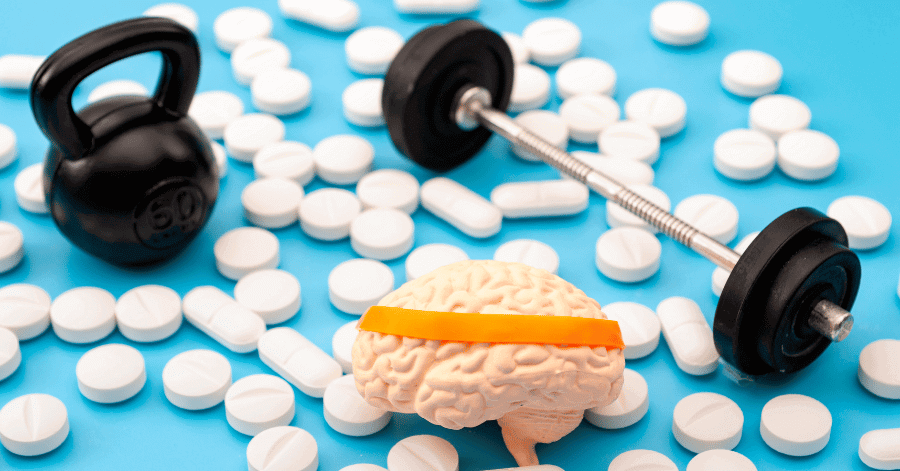
Nootropics, also know as “smart drugs”, are compounds that improve cognitive performance such as memory, attention, focus, and clarity.

Rejection sensitivity, and its unofficial diagnosis RSD, is thought to be related to ADHD, often mistaken as a symptom. But rejection sensitivity can be treated.
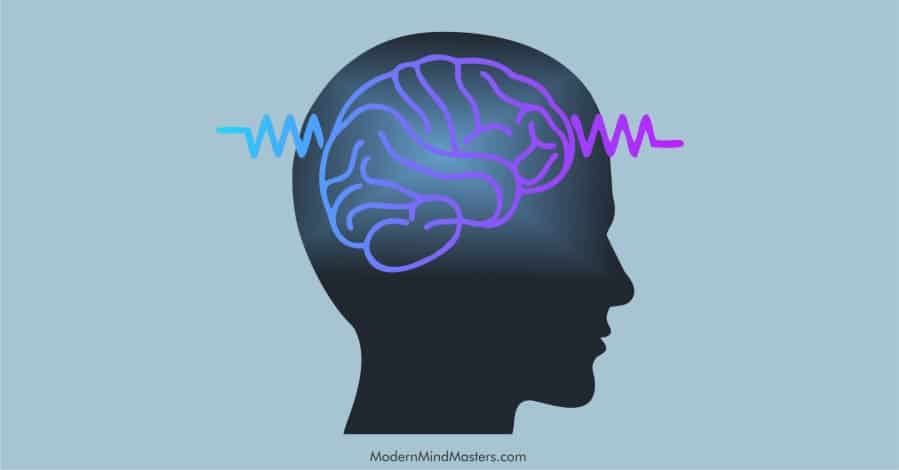
Higher dopamine levels increase motivation and drive over the short term, but consistent use longer-term will have the opposite effect. Learn the negative effects of increasing your dopamine and how to use it optimally.

Logical and rational thoughts stem from the conscious mind, whereas emotional and impulsive thoughts are induced from the subconscious mind, which is beyond our control.

Do you really need fiber, or is this simply an overhyped myth? Science and anecdotal evidence now suggest the body can run better without it when on a low-carbohydrate diet.
© 2025 Modern Mind Masters - All Rights Reserved
You’ll Learn:
Effective Immediately: 5 Powerful Changes Now, To Improve Your Life Tomorrow.
Click the purple button and we’ll email you your free copy.
from lockdown I started using YouTube and slowly got addicted to it and soon after in 2022 the lockdown ended I started to go school again .the problems I faced was like a punishment to me . I gain so much fat my legs were to much in pain because of injury . I used to do skating and was the best in school. But after getting in high school everybody started to hate me and bully me . This was trauma for me and stayed for like 2 year and till now . Now I am slowly leaving my addiction and started to work out and follow dopamine detox routine let’s see if I will be successful or not . but I am confirmed that I will get my level back . But truly this is not easy . If you do it correctly you will definitely change
I’m sorry to hear what you’ve been through, the lockdowns were a very tough time for many. Although the trauma sucks, change is a matter of time and consistency. Small improvements every day mean change is a matter of when not if. Feel free to reach out to me if you need to talk.